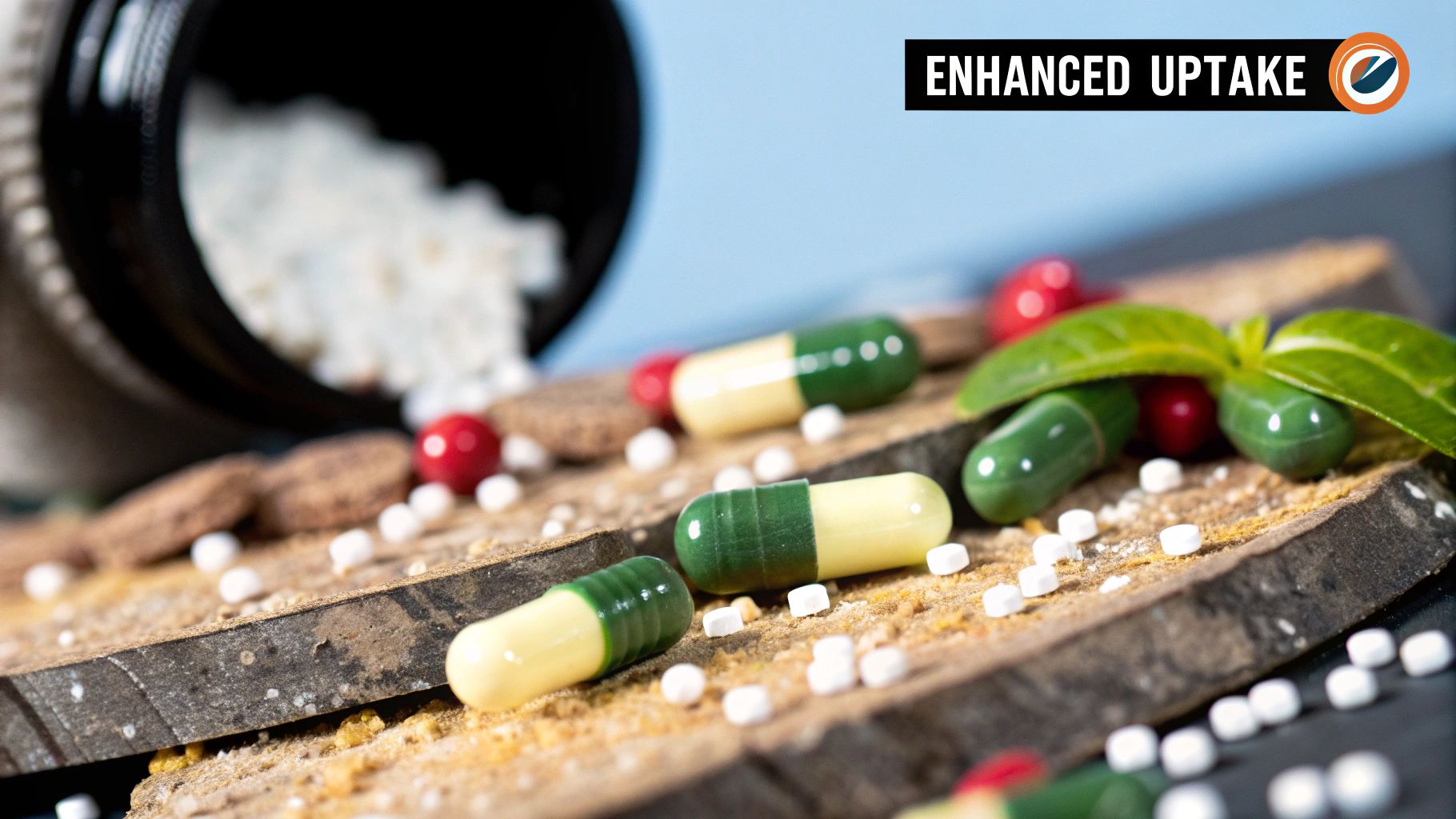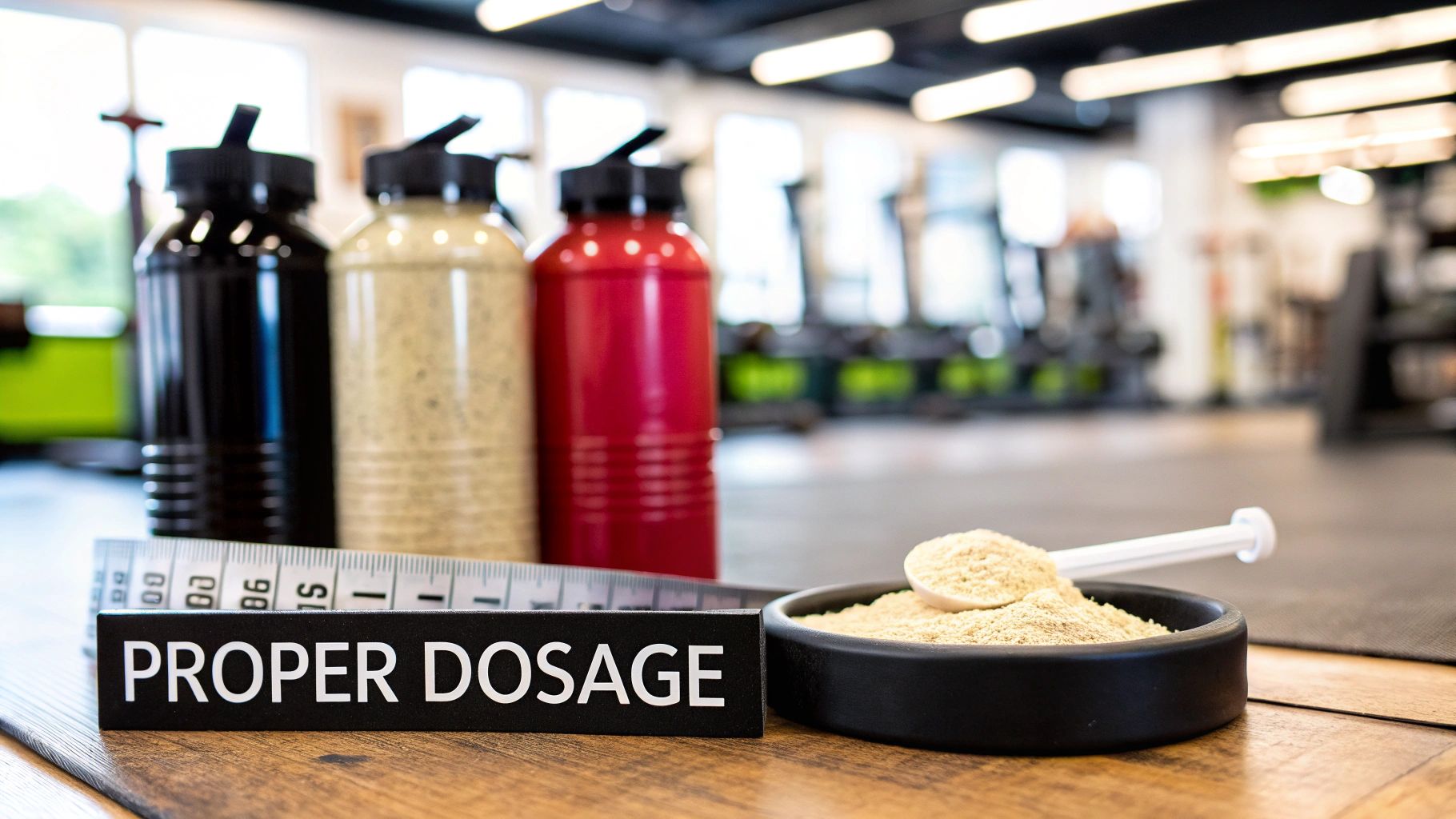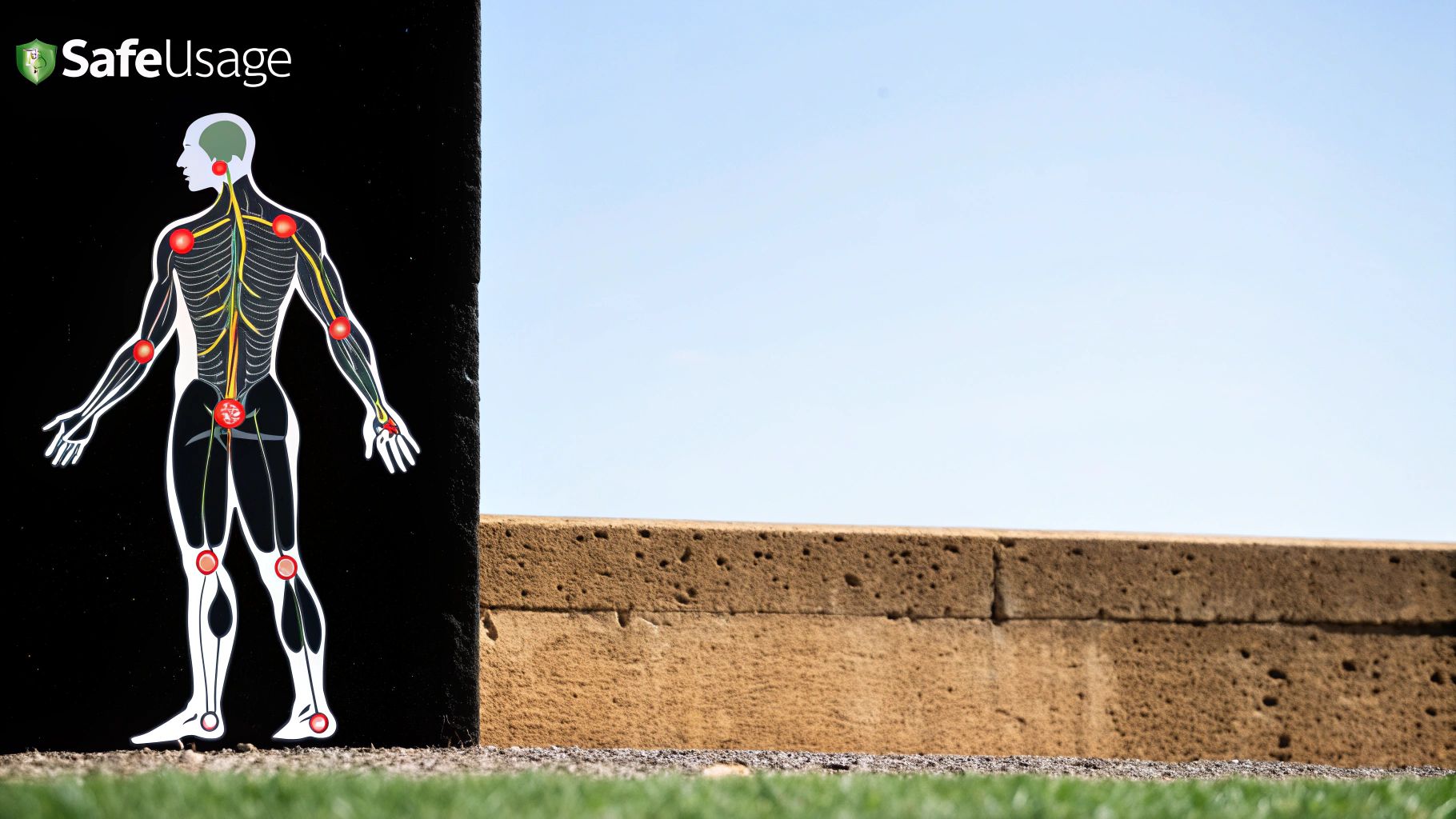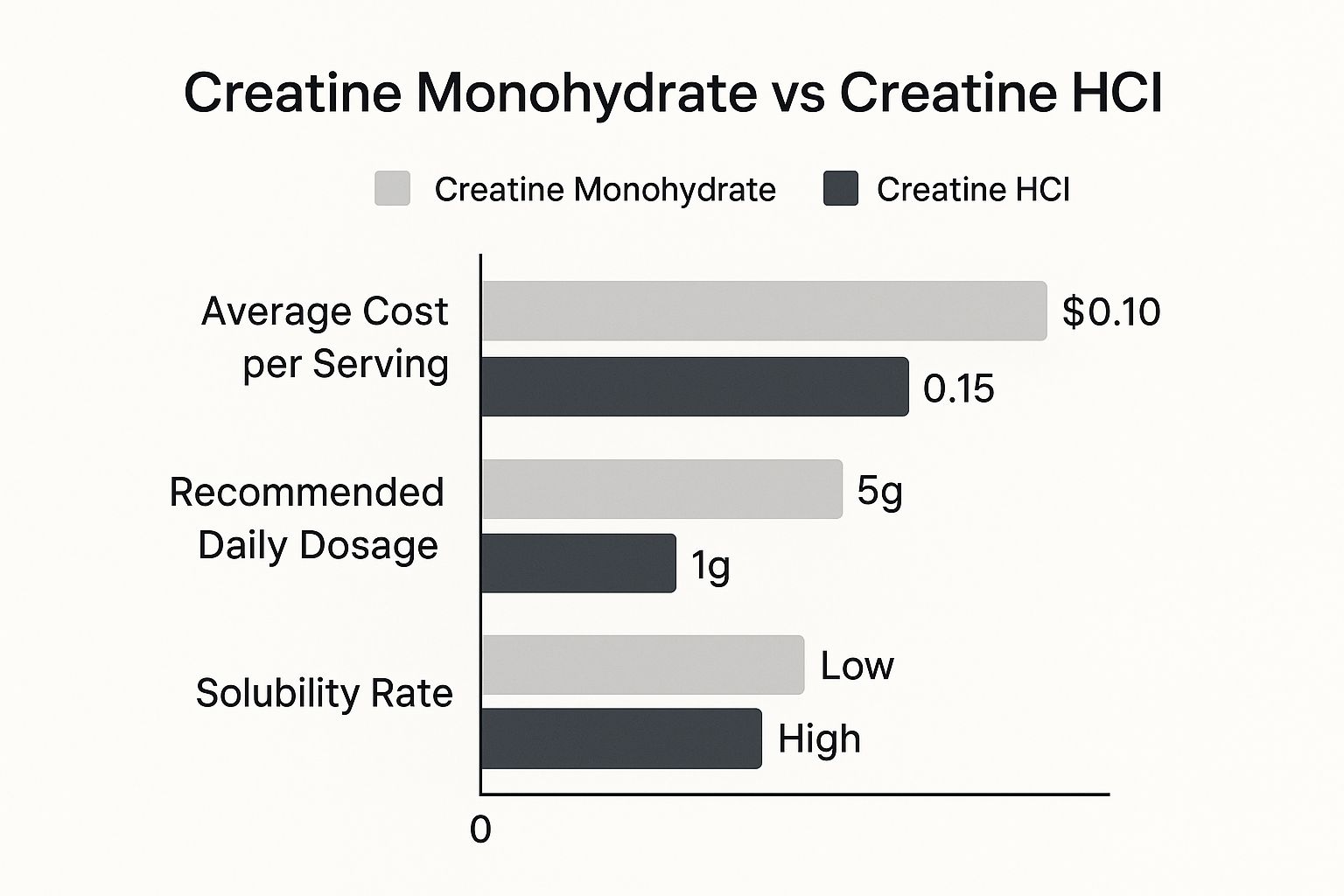
Creatine Hydrochloride vs Monohydrate: Which Is Best for You?
Share
When you get right down to it, the choice between creatine hydrochloride and monohydrate boils down to a simple question: Do you stick with the proven, time-tested champion or bet on the newer, more refined contender? Creatine monohydrate is the undisputed gold standard, backed by decades of research and a mountain of evidence. On the other hand, creatine hydrochloride (HCl) is the challenger, engineered for better solubility and aimed at users who experience digestive issues with the classic formula.
Ultimately, your decision hinges on what you value most. Are you looking for guaranteed results at a great price, or are you willing to invest a bit more for the possibility of a smoother experience?
Understanding the Two Main Competitors
Walking into the supplement aisle feels like navigating a maze. You'll see dozens of tubs all promising the same thing, but the real contest is between two key players: creatine monohydrate and creatine hydrochloride (HCl). To pick the right one for your goals, you need to look past the flashy labels and understand what truly separates them. This guide will do just that, giving you a straight-up comparison based on science, practical use, and your wallet.
Creatine Monohydrate: The Proven Standard
Creatine monohydrate isn't just another supplement; it's the original. It's the most studied form of creatine on the market, with hundreds of clinical trials confirming its safety and effectiveness. For years, it's been the go-to for athletes and gym-goers for one simple reason: it works. It consistently helps increase strength, boost power, and build muscle.
- Extensive Research: Supported by a massive body of scientific work that validates its benefits.
- Proven Efficacy: There's no debate—it's incredibly effective for improving performance in a wide range of sports.
- Cost-Effective: It’s almost always the most affordable option, delivering the best bang for your buck.
Creatine Hydrochloride: The Modern Alternative
Creatine HCl is a relative newcomer, developed specifically to tackle some of monohydrate's known issues—namely, its tendency to not dissolve completely and cause stomach discomfort for some people. By attaching creatine to a hydrochloride molecule, formulators created a version that mixes much more easily in water.
This enhanced solubility is the basis for claims of better absorption, which would mean you could get the same results with a smaller dose and sidestep side effects like bloating. While monohydrate still rules the market, these specialized benefits have helped variants like HCl carve out a niche. The global creatine market was valued at around USD 514.4 million and continues to grow as new forms compete for attention. You can learn more about the creatine supplement market growth and trends.
Key Takeaway: The core of this debate pits monohydrate's overwhelming scientific proof against HCl's promise of better solubility and easier digestion.
Before we dive deeper, let's start with a high-level look at how these two stack up.
This table provides a high-level summary of the key distinctions between Creatine Hydrochloride and Creatine Monohydrate.
Quick Comparison: Creatine HCl vs Monohydrate
| Feature | Creatine Monohydrate | Creatine Hydrochloride (HCl) |
|---|---|---|
| Scientific Backing | Extremely high; hundreds of studies | Very low; limited human trials |
| Solubility in Water | Lower; can leave residue | Higher; dissolves easily |
| Standard Daily Dose | 3-5 grams | 1-2 grams |
| Cost Per Serving | Low | High |
| Potential Side Effects | Bloating/GI issues in some users | Marketed as having fewer GI issues |
This quick snapshot gives us a solid starting point, but the real story is in the details. Now, let's break down each of these points to figure out which creatine is truly the best fit for you.
Understanding the Molecular Differences

To really get to the bottom of the creatine hydrochloride vs. monohydrate debate, we have to look at their chemistry. At their heart, both are built on the same creatine compound, but it’s the molecule attached to this core that makes all the difference in the real world.
Think of it like this: the base creatine is the engine. The molecule it’s bonded to is the transmission. Both get the job done, but they deliver power and handle differently.
The Structure of Creatine Monohydrate
Creatine monohydrate is the form you’ve heard about for decades—the original and still the gold standard. Its name gives away its structure: it's a single creatine molecule bonded to one water molecule. "Mono" means one, and "hydrate" means water. This simple, stable bond is the reason it’s been the subject of hundreds of studies.
That water molecule gives it incredible stability, but it’s also the culprit behind its notoriously poor solubility. If you’ve ever mixed a scoop of monohydrate, you know exactly what I mean—that gritty residue at the bottom of your shaker is the undissolved creatine.
Key Insight: The water molecule is both a blessing and a curse. It provides the stability that makes monohydrate so reliable and well-researched, but it also compromises its ability to dissolve easily.
Still, it’s this exact chemical makeup that has proven its worth time and time again for boosting muscle, strength, and overall athletic performance. It's simple, effective, and has an unparalleled track record.
The Design of Creatine Hydrochloride (HCl)
Creatine hydrochloride (HCl) came along as a direct response to monohydrate's biggest practical flaw: its mixability. Instead of bonding creatine to water, scientists attached it to a hydrochloride molecule. It's a small change on paper, but it has a huge impact.
Adding the hydrochloride makes the compound more acidic, which in turn makes it incredibly soluble in water. Creatine HCl dissolves almost instantly, leaving behind a clear liquid with no sandy leftover. This is its main selling point.
The entire theory behind creatine HCl is built on this solubility:
- Better Solubility: It mixes perfectly in water, and the idea is that it will do the same in your stomach.
- Increased Absorption: Proponents argue that because it dissolves better, your body can absorb it more efficiently.
- Lower Dosage: Following that logic, you shouldn't need as much HCl to get the same effect as monohydrate.
This molecular tweak was a clever bit of engineering aimed at fixing a common user complaint. While the jury is still out on whether this translates to better results in the gym, the chemical difference is clear. It's this simple distinction—water molecule vs. hydrochloride—that fuels the entire creatine hydrochloride vs monohydrate debate.
Solubility vs. Real-World Absorption: What Really Matters?

The biggest selling point for creatine HCl comes down to one thing: solubility. If you’ve ever mixed both, you know the difference is stark. HCl dissolves almost instantly, leaving your drink crystal clear. Monohydrate, on the other hand, can be a bit stubborn, often leaving a gritty layer at the bottom of your shaker.
This visual difference is the entire foundation of HCl's marketing. The argument goes like this: because it dissolves better in water, it must be absorbed more efficiently by your body. This has led to claims that you can get the same results with a much smaller dose of HCl, all while skipping the potential stomach issues.
But this is where we have to pause and separate what happens in a glass of water from what goes on inside the incredibly complex environment of the human gut.
The Myth: Does Better Solubility Mean Better Absorption?
While creatine HCl is, without a doubt, more soluble, the idea that this automatically means superior absorption is a huge leap. Our bodies are already incredibly good at absorbing creatine monohydrate, despite its less-than-perfect mixability. In fact, study after study has shown that the bioavailability of creatine monohydrate is over 99%.
Let that sink in. Nearly every bit of monohydrate you swallow makes its way from your digestive system into your bloodstream, ready to be shuttled to your muscles. Your stomach acid is a powerful solvent, and your digestive system is far more effective than a shaker cup at breaking down and absorbing what you consume.
Key Takeaway: Superior solubility in a glass doesn't automatically mean superior bioavailability in your body. The digestive system is a highly efficient processing plant that already absorbs creatine monohydrate with near-perfect effectiveness.
So, while HCl's clean mixing is a nice perk, its impact on actual absorption is a moot point when monohydrate is already at the top of its class.
Following the Science
When we look at the research comparing creatine hydrochloride vs. monohydrate, a major issue pops up: there’s a serious lack of human studies on HCl. The theory behind its molecular structure leading to better uptake is interesting, but it just isn't supported by a solid body of clinical evidence in athletes.
In sharp contrast, creatine monohydrate is one of the most studied sports supplements on the planet, with hundreds of trials backing its efficacy and absorption. It's the gold standard for a reason. The case for HCl's enhanced bioavailability rests more on chemical theory and marketing than on proven results in human performance.
While creatine hydrochloride (HCl) is a newer player, its main differentiator remains its high water solubility. This property is touted to reduce sediment, improve absorption, and allow for smaller doses, which may in turn minimize side effects like bloating. To get a broader perspective on the market, you can find more insights on the U.S. creatine market on Grand View Research.
What This Means for You
So, how does this translate to your choice in the supplement aisle? It means the main benefit you get from choosing creatine HCl is convenience—not necessarily better results.
Let’s break it down into a few practical scenarios:
- If you just want a smooth drink: For anyone who can't stand the gritty texture of other powders, HCl is a clear winner. It delivers a much better drinking experience, hands down.
- If you're all about proven results: For the athlete whose primary goal is muscle saturation and performance, monohydrate's 99% absorption rate is a scientifically-backed guarantee. The unproven, and likely tiny, absorption benefit from HCl probably doesn't justify the higher price tag.
- If you have a sensitive stomach: This is where HCl might have a real advantage. Because the recommended dose is smaller and it dissolves so quickly, it could reduce the risk of bloating or stomach cramps for those who are sensitive to monohydrate.
Ultimately, the chemistry of solubility is cool, but the biology of absorption tells the real story. Your body is already phenomenal at using creatine monohydrate, making the debate less about which one is absorbed "better" and more about which one best fits your personal preference, stomach sensitivity, and budget.
Comparing Muscle Growth and Performance Outcomes

When you strip away the marketing hype and fancy chemical names, there’s really only one question that matters: which one works better in the gym? This is where the debate between creatine HCl and monohydrate gets real.
For decades, creatine monohydrate has been the undisputed king of performance supplements. It’s not just popular; it’s one of the most thoroughly researched ingredients in the entire history of sports nutrition.
The Overwhelming Evidence for Monohydrate
The scientific case for creatine monohydrate is massive. We're talking about hundreds of peer-reviewed studies that consistently show it delivers a significant boost to athletic performance. The data is about as clear as it gets.
When athletes add monohydrate to their regimen, they see real, measurable gains across the board:
- Increased Maximal Strength: On average, users see an 8% greater increase in strength compared to placebo groups when combined with resistance training.
- Enhanced Power Output: It’s proven to help you generate more explosive force—essential for everything from sprinting and jumping to that heavy last rep.
- Accelerated Muscle Growth: Monohydrate helps you handle more training volume (more reps and sets), which is a direct driver of hypertrophy. You can dive deeper into how creatine builds muscle in our detailed guide.
- Improved Anaerobic Capacity: It helps you fight off fatigue during high-intensity sessions, letting you push harder for longer.
This mountain of evidence confirms that monohydrate is a reliable and incredibly effective tool for anyone serious about hitting their goals.
The Scientific Landscape for Creatine HCl
In sharp contrast, the research backing creatine HCl’s performance benefits is thin. While the chemistry is interesting, the number of human trials directly comparing its muscle-building effects to monohydrate is extremely small.
Most of the claims are theoretical or based on anecdotal reports from users. A few preliminary studies hint that HCl might offer similar benefits, but these are typically small-scale and short-term. There just isn't the robust, large-scale science to confidently say it works as well as, let alone better than, its time-tested rival.
The Bottom Line: While you'll hear plenty of people say they love creatine HCl, personal stories aren't a substitute for hard science. Creatine monohydrate is the only form with decades of overwhelming evidence proving it flat-out works for building muscle and boosting performance.
Market Dominance and Proven Results
This research gap is mirrored in the market itself. Creatine monohydrate dominates the global creatine market because it’s proven and affordable. The monohydrate segment is expected to hit around USD 520.46 million and grow at a CAGR of roughly 9% through 2032, proving just how much athletes and consumers trust it for muscle strength and recovery.
When it comes to proven results, the verdict is clear: creatine monohydrate has been tested relentlessly and consistently delivers. While HCl might offer a different user experience, it simply doesn’t have the scientific pedigree to dethrone the king.
A Practical Comparison of Dosage, Cost, and Side Effects
Let's move past the chemistry and get into what really matters for your daily routine: how much to take, how it feels, and what it costs. When you're deciding between creatine monohydrate and hydrochloride, these are the three factors where the differences truly become clear.
Dosage: The "Micro-Dose" Myth
The standard protocol for creatine monohydrate is rock-solid and backed by decades of research: a daily dose of 3-5 grams. This amount is proven to effectively saturate your muscles and deliver reliable performance gains.
Creatine HCl, on the other hand, is marketed with a much smaller recommended dose, usually around 1-2 grams per day. This "micro-dosing" strategy is based on the idea that its better solubility means you absorb more, so you need less. While the theory is interesting, the real-world performance evidence just isn't there yet to back it up like it is for monohydrate.
Side Effects: The Gut Check
One of the longest-standing complaints about creatine monohydrate is the risk of bloating or stomach discomfort. This is almost always tied to its lower solubility. If you don't mix it with enough liquid, undissolved particles can pull water into your gut, which can cause issues for some people. The good news? For most of us, simply drinking enough water makes this a non-issue.
This is where creatine HCl shines. It was literally designed to solve this problem. Because it dissolves so easily, proponents argue that it's much gentler on the stomach. If you're one of the few who experiences persistent GI issues with monohydrate even with plenty of water, HCl is a very appealing alternative. This is particularly important since the complete guide on creatine benefits for women shows how consistency is key to unlocking benefits like enhanced cognition and muscle toning.
Cost: The Price of Innovation
You might think that a smaller dose would make HCl cheaper in the long run, but a quick look at the price tag tells a different story. Manufacturing creatine HCl is a more involved and expensive process, and that cost gets passed on to you.
When you break it down to cost per serving, monohydrate wins by a landslide. Even with a larger scoop size, the price per gram is dramatically lower, making it the undisputed champion for anyone looking for proven results without breaking the bank.
Here’s a simple table to put these practical differences side-by-side.
Practical Comparison: Monohydrate vs. HCl
| Attribute | Creatine Monohydrate | Creatine Hydrochloride (HCl) |
|---|---|---|
| Daily Dosage | 3-5 grams (heavily researched) | 1-2 grams (less research) |
| Side Effects | Low risk; potential GI upset for some | Very low risk; designed for easy digestion |
| Cost Per Serving | Very low | High; often 3-4x more expensive |
This table makes the choice pretty clear. Monohydrate is the cost-effective, proven standard, while HCl is a premium option for those with sensitive stomachs who don't mind the higher price.
Key Insight: The trade-off is straightforward. With creatine HCl, you’re paying a premium for superior mixability and a potentially gentler experience on your digestive system. With monohydrate, you get the most scientifically validated supplement on the market for a fraction of the cost.
This visual breakdown drives home the key differences in dosage, cost, and solubility.

As the chart shows, while the daily dose for HCl is smaller, its cost per serving is significantly higher, cementing monohydrate's position as the go-to for value.
Ultimately, the decision comes down to your personal priorities. Is avoiding potential stomach discomfort worth the much higher price tag of HCl? For most people, the unbeatable value and proven effectiveness of creatine monohydrate make it the obvious place to start.
How to Choose the Right Creatine for Your Goals
When you're standing in the supplement aisle, staring down two tubs labeled "Creatine Monohydrate" and "Creatine HCl," the choice can feel complicated. But it really boils down to your individual body, goals, and budget. There isn’t one single "best" form for everyone, but there’s definitely a best choice for you.
For the overwhelming majority of people, creatine monohydrate is the definitive starting point. It's the most researched sports supplement on the planet, with decades of solid science backing its ability to boost strength, power, and muscle growth. It’s cheap, proven safe, and flat-out works.
When to Stick with Monohydrate
You should probably grab the monohydrate if any of these sound like you:
- You're new to creatine: Don't overcomplicate it. Monohydrate has a proven track record, making it the perfect benchmark to see how your body responds.
- Proven performance is your only goal: Hundreds of studies confirm monohydrate’s effectiveness. You can’t get more reliable than that.
- You're on a budget: It delivers the best bang for your buck, offering all the science-backed benefits at a much lower cost.
The verdict is simple for most: start with the gold standard. Creatine monohydrate has earned its reputation as the most trusted performance supplement for a reason—it works consistently and affordably.
When to Consider Creatine HCl
So, where does creatine HCl fit in? It serves a very specific purpose for a small subset of users. It's not a magic bullet for better performance, but its unique chemical structure solves a common problem for some.
Think about switching to creatine HCl only if you've already given monohydrate a fair shot and experienced persistent digestive issues like bloating or cramping. Even with plenty of water, some people just don't tolerate monohydrate well. HCl's superior solubility often means it's gentler on the stomach, which can make it a worthwhile upgrade for those sensitive individuals.
After you've picked your creatine, it's just as important to understand the essential do's and don'ts for creatine supplementation to get the best results.
Ultimately, the decision is a simple trade-off between proven, cost-effective results and personal comfort. For nearly everyone, monohydrate is the smartest, most logical choice. But if you're one of the unlucky few who struggle with side effects, HCl offers a great, practical solution.
To make sure you're using either form correctly, check out this comprehensive creatine dosage guide for beginner to expert results. It will help you maximize your gains safely and effectively.
Frequently Asked Questions
Even after a deep dive, you probably have a few lingering questions. It's totally normal. Let's clear up some of the most common uncertainties people have when deciding between creatine hydrochloride and monohydrate.
Is a Loading Phase Necessary for Creatine HCl?
With creatine monohydrate, you often hear about the "loading phase"—that initial week of taking around 20 grams a day to quickly saturate your muscles. It works, but it’s not for everyone.
Creatine HCl was basically designed to sidestep this whole process. The big selling point is its enhanced solubility, which theoretically leads to better absorption. The idea is that a much smaller daily dose, just 1-2 grams, is enough to get the job done over time, making a high-dose loading phase unnecessary. You can skip loading with monohydrate too, it just takes a bit longer to max out your stores, but HCl is marketed specifically for this simpler, no-load approach.
Is One Form of Creatine Safer Than the Other?
Both creatine monohydrate and HCl are considered very safe for healthy people sticking to the recommended doses. Creatine monohydrate, however, has an absolute mountain of research behind it—we're talking hundreds of studies spanning decades. It's one of the most thoroughly vetted supplements on the planet, with an outstanding safety record.
Creatine HCl doesn't have the same long-term research pedigree, but it’s also widely regarded as safe. The main difference you might notice comes down to digestion. HCl is often the go-to for people who get stomach cramps or bloating from monohydrate.
Key Insight: Don't get hung up on safety as the deciding factor. Monohydrate has more paper behind it, but both are safe. The real choice here is usually about what your stomach can handle, not which one is inherently safer.
Can You Switch Between Creatine Monohydrate and HCl?
Absolutely. Your muscles don't care where the creatine molecule came from once it's in your system. The goal is just to keep those muscles saturated, and you can switch between forms without missing a beat.
If you're moving from monohydrate to HCl, just stop one and start the other at its recommended daily dose. There's no need for a "washout" period or any complicated transition. It's a seamless switch, so feel free to experiment to find what works best for your body and your wallet.
Ready to skip the powders and messy shakers altogether? Smash.com offers the power of 5g of premium creatine in delicious, convenient gummies. No mixing, no mess, just proven results. Fuel your goals and smash your targets with Smash.com.